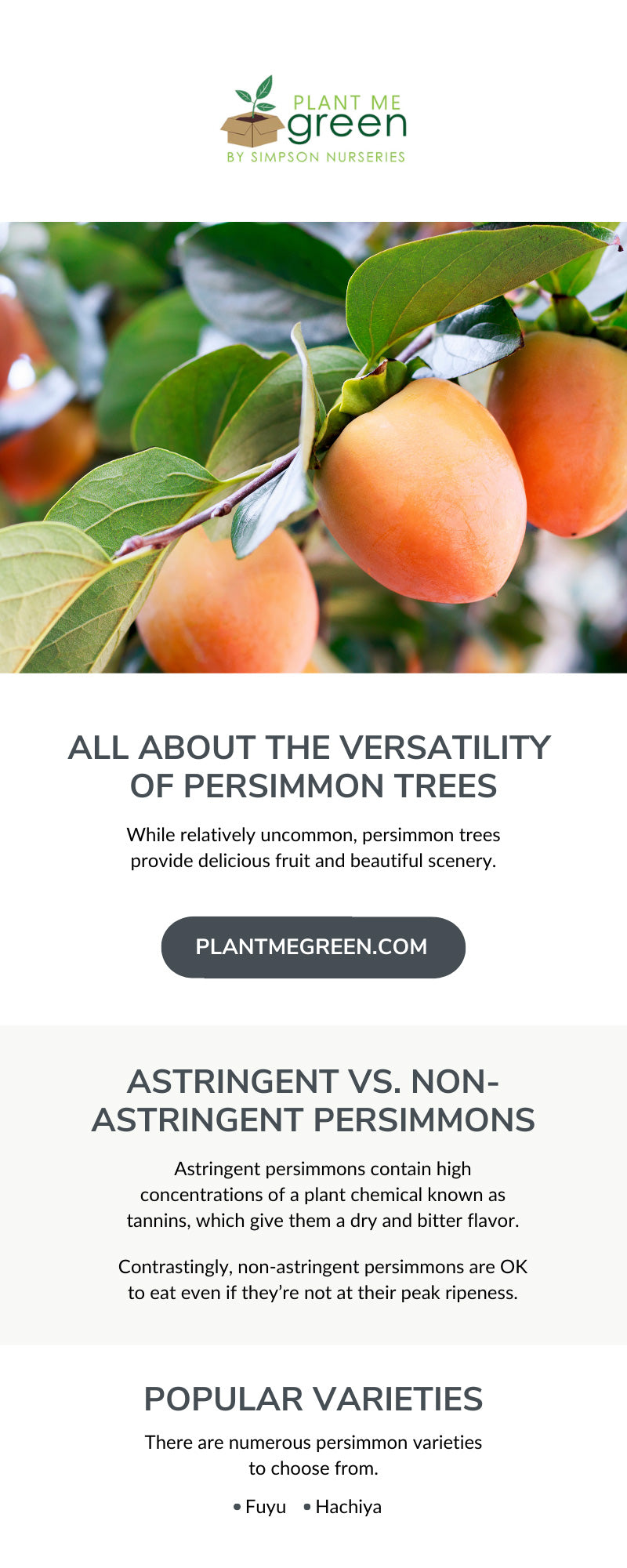Unless you’ve seen a persimmon tree in person, its vibrance and beauty are indescribable. The fruit appears in shades of orange, red, and brown and takes on the shape of a tomato or pepper. However, don’t let the shape fool you, as persimmons are sweet and tangy. Learn all about the versatility of persimmon trees and why you should consider planting them on your property.
Astringent vs. Non-Astringent Persimmons
Although there are several persimmon varieties, every variety is either astringent or non-astringent. These subcategories differ in their texture, flavor, and best uses. Knowing the difference between astringent and non-astringent varieties is an essential piece of information when it comes to eating persimmon fruit.
Astringent
Astringent persimmons contain high concentrations of a plant chemical known as tannins, which give them a dry and bitter flavor. As a result, you must wait for them to ripen before eating them. When astringent persimmons are ripe, they’ll feel soft and mushy to the touch. Once they reach their peak ripeness, persimmons are one of the sweetest, richest, and juiciest fruits you’ll ever taste.
Non-Astringent
Contrastingly, non-astringent persimmons are OK to eat even if they’re not at their peak ripeness. In fact, you can pick one directly from the tree and bite into it like an apple! However, this type isn’t nearly as sweet as astringent persimmons; the mild sweetness is comparable to a melon.
Popular Varieties
Aside from the basic subcategories above, there are numerous persimmon varieties to choose from. Explore the difference between a couple of the most popular varieties and determine which one might be a good option for you!
Fuyu
Fuyu persimmons are a non-astringent Asian variety without a core, seeds, or tannins. They’re typically orange like a pumpkin but have a rounded shape like a tomato. In addition, their flavor is sweet, like a pear with hints of brown sugar and cinnamon, making them an ideal choice for eating fresh, cooking, or baking. Interestingly, the Fuyu persimmon is the most widely cultivated variety worldwide.
Hachiya
Hachiya persimmons are an astringent Asian variety with an elongated shape and yellow-orange to red-orange skin. Because they’re astringent, it’s best to wait until peak ripeness before eating. A Hachiya persimmon’s skin becomes slightly wrinkled and more transparent as it moves closer to ripeness.
When ripe, they’ll feel soft and delicate to the touch. The tannins break down inside the fruit as they mature, leaving you with an ultra-sweet, honey-flavored fruit.
A Perfect Accent Tree
The beautiful flowers and bright, brilliant color of the fruit make persimmon trees one of the best options for a single accent tree on your property. Whether it’s in your backyard, front yard, or along your sidewalk, a persimmon tree won’t disappoint you when it comes to beauty.
In addition, persimmon trees can withstand less-than-desirable growing conditions. While they prefer full sunlight, well-drained, slightly acidic soil, and warm climates, many persimmon tree varieties tolerate shade, poor soil conditions, and cooler climates. Another reason to buy persimmon trees online is that there is little to no risk of pest issues or diseases, so you can trust they will travel well.
Self-Pollinating Capabilities
A massive bonus of planting an Asian persimmon tree is that they’re self-pollinating, meaning they don’t need an external pollinator to produce fruit. This characteristic is possible because they make both male and female flowers on the same tree, sometimes called perfect flowers. As a result, the male flowers are able to pollinate the female flowers on the same tree.
Because Asian persimmon trees are self-pollinating, you don’t have to plant more than one tree if you don’t want to. However, planting an Asian and an American variety won’t cause them to cross-pollinate.
Persimmon Recipes
Although persimmons are incredible when you eat them fresh, they’re an excellent fruit to use in numerous foods, from breakfast to dinner to dessert. Consider adding these dishes to your recipe book!
Almond Persimmon Pancakes
Almond persimmon pancakes are the ultimate winter breakfast, and they’re so simple to make. Make pancake batter as you normally would, but add a splash of almond extract and about a ½ cup of persimmon puree. Cook the pancakes on a skillet as usual.
In a saucepan, combine the rest of your persimmon puree with a splash of almond extract and let it simmer. Top off your pancakes with the warm puree and toasted almonds for a delightful breakfast dish.
Persimmon Salad
Combine persimmon, apples, pumpkin seeds, and goat cheese with your favorite leafy greens for a delicious and refreshing salad. A persimmon salad is an easy option for lunch or dinner that’s also incredibly nutritious. Consider adding persimmon to different types of salads to find your personal favorite combination.
Persimmon Pudding
Persimmon pudding is a perfect dessert for your fall and winter gatherings, and it pairs well with a scoop of vanilla ice cream or a dollop of whipped cream. You’ll need to make a persimmon puree and combine it with grated carrots, melted butter, egg, walnuts, raisins, buttermilk, flour, and sugar.
Once you have your mixture, transfer it to a mold or baking dish. Place the dish in a larger bowl and surround it with hot water to create a steaming effect. It’ll take about an hour for the pudding to set, and then it’s ready to enjoy!
Medicinal Qualities
Aside from their visual appeal and delicious flavor, persimmons also have amazing health benefits. For that reason, you should consider adding them to your regular diet.
Heart Health
Regularly consuming persimmons can decrease your risk of heart disease because they help keep your arteries clear. Additionally, they help regulate blood pressure, and the tannin-rich fiber helps lower high cholesterol.
Eye Health
One serving of persimmon contains a large concentration of vitamin A, which is necessary for good eye health. In addition, they also contain lutein, which is known to help prevent eye disease.
Diabetes Prevention and Support
Persimmon peels contain flavonoids, which have numerous antioxidants and antidiabetic properties. They’re also high in soluble fiber, which prevents spikes in your blood sugar by slowing the digestion of carbohydrates.
Learning all about the versatility of persimmon trees is nearly as incredible and fascinating as watching them grow. Although you might not be familiar with persimmon trees, you should consider planting one on your property for their stunning bright orange hues and delectable fruit. Once you get a taste of persimmons, they’ll be hard to resist!



